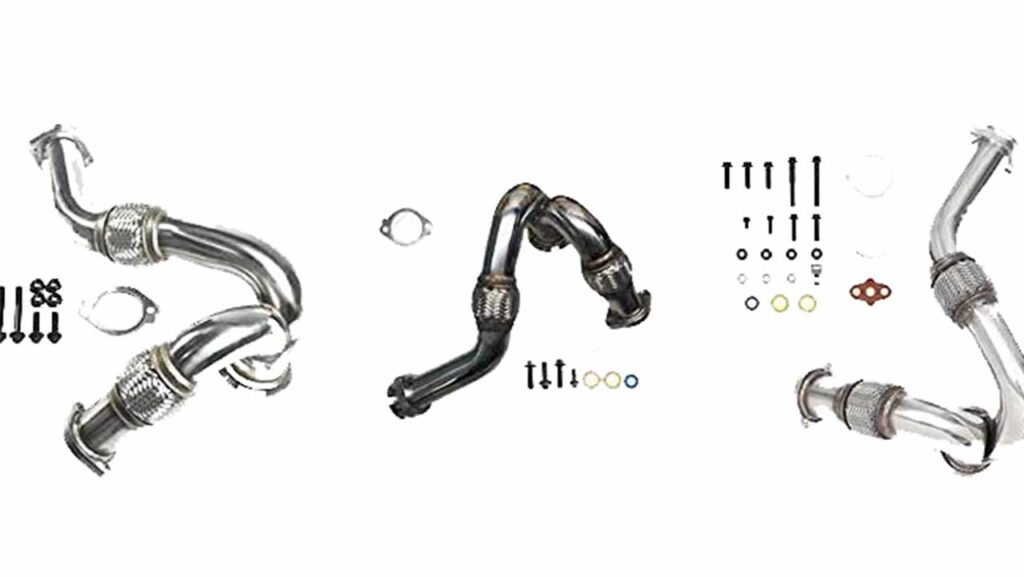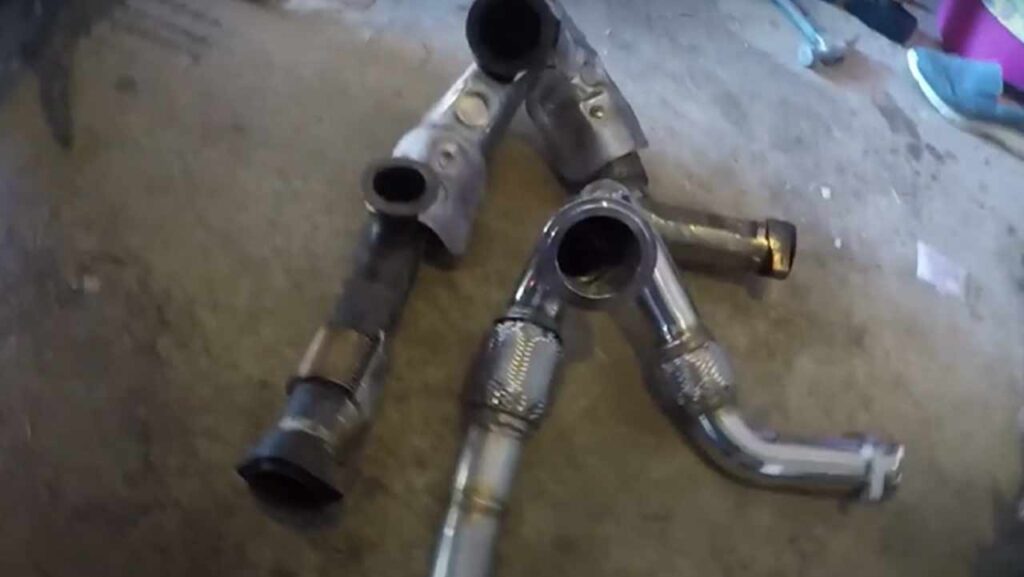Removing a 6.0 Y Pipe is relatively straightforward, as long as you have the right tools and know what to do. The first step is to locate the two nuts that hold the pipe in place on either side of the engine bay. Once located, use an adjustable wrench or socket to loosen both nuts until they can be removed from their respective bolts.
Then carefully remove the Y pipe from its mounting points and set it aside for disposal or re-use. If necessary, you may need to disconnect any hoses or clamps connected to it before attempting removal.
6.0 Powerstroke Y-Pipe
The 6.0 Powerstroke Y-Pipe is an essential component of the 6.0L diesel engine and is designed to improve exhaust flow, reduce backpressure, and increase horsepower and torque. The Y-pipe helps the turbocharger spool up faster for improved throttle response and better fuel economy. It also helps with cold start emissions by allowing air to flow more freely through the intake system while keeping soot particles out of the intake manifold.
Installing a high quality aftermarket Y-pipe will give your truck that extra edge it needs to reach its full potential.
Ford 6.0 Cracked Y Pipe Symptoms
The most common symptom of a cracked 6.0 Y pipe in a Ford vehicle is an exhaust leak. This can be heard as an unusual hissing, ticking or thumping noise coming from underneath the car, and it will become more noticeable with acceleration. Other symptoms include reduced fuel economy due to exhaust gases entering the cabin, increased engine temperature, and decreased power when accelerating from a stop.
If you think your Ford has this issue, have it serviced by a qualified mechanic as soon as possible to prevent further damage to your engine.
6.0 Y Pipe Replacement Cost
Replacing a 6.0 Y pipe can be quite costly, depending on the make and model of your vehicle. The cost for replacement parts alone will typically range from around $200 to $400, but labor costs can add up quickly as well. In total, expect to pay anywhere from $300 to over $1000 for a complete 6.0 Y pipe replacement job.
6.0 Powerstroke Y Pipe Replacement
Replacing the Y pipe on your 6.0 Powerstroke engine is a relatively straightforward procedure when completed correctly. The key to success lies in carefully following the manufacturer’s instructions and ensuring that all of the necessary components are present and securely fastened before proceeding with installation. The Y pipe replacement process requires basic tools, knowledge of your vehicle’s exhaust system, and around an hour of time for completion.
Doing this job yourself can be much more cost-effective than taking it to a shop or mechanic, so if you have any mechanical experience then it may be worth giving it a try!
6.0 Powerstroke Up-Pipe Upgrade
The 6.0 Powerstroke Up-Pipe Upgrade is a great way to improve your truck’s performance, efficiency and overall driving experience. The upgrade increases the flow of exhaust gases from the turbocharger to the exhaust manifold, resulting in quicker spool-up times and improved throttle response. Additionally, it reduces backpressure in the exhaust system which helps produce more power with less heat buildup.
By upgrading your up-pipe you can expect improved fuel economy, better low end torque and an increase in horsepower for added acceleration on demand.

How Do You Test the Icp Sensor on a 6.0 Powerstroke?
Testing the ICP sensor on a 6.0 PowerStroke is not complicated and can be done with some basic hand tools and a few simple steps. The first step in testing an ICP sensor is to disconnect the plug located at the rear of the engine near the power steering pump. Once disconnected, you will need to locate where your test light or multimeter should go.
Generally, if you have access to a wiring diagram for your vehicle, it will show that one side of your test light or meter goes into pin 16 while the other side connects to ground. After connecting your device properly, crank or start up your engine until it reaches operating temperature then check both pins on either side of pin 16 for voltage readings – usually between 5-12 volts depending on idle speed and throttle position. If no reading appears after cranking then this indicates there may be an issue with either the ICP itself or associated components such as wiring/connectors which could require further investigation using more advanced diagnostic methods.
What is the Ipr on a 6.0 Powerstroke?
The International Powerstroke Registry (IPR) is a non-profit organization dedicated to the preservation, restoration and documentation of Fords’ 6.0L PowerStroke diesel engines. Founded in 2012, IPR is the only registry of its kind and offers an extensive database that includes over 1 million entries detailing the history of these iconic engines. Through their website and online forum, members can share information about problems they have encountered with their 6.0L engine as well as tips for keeping it running smoothly.
Additionally, IPR also provides technical advice from qualified mechanics on how to maintain your vehicle so you can ensure it’s always up to factory specs. They even provide support for aftermarket parts that are compatible with your engine so you can customize it without compromising performance or reliability. Whether you’re a die-hard enthusiast or just want reliable transportation, IPR has something for everyone in regards to getting maximum enjoyment out of this legendary powerplant!
What is the Best Y Pipe For 6.0 Powerstroke?
The Y pipe in a 6.0 Powerstroke engine connects the exhaust manifolds to the turbocharger. Upgrading to a performance Y pipe can increase the engine’s power and efficiency by reducing exhaust backpressure and improving exhaust flow.
There are many brands and models of Y pipes available for the 6.0 Powerstroke, each with their own unique features and benefits. Some popular options include the MBRP Y-Pipe, the Diamond Eye Y-Pipe, and the BD Diesel Y-Pipe.
When selecting a Y pipe for your 6.0 Powerstroke, it’s important to consider factors such as material quality, fitment, and price. It’s also a good idea to read reviews and consult with other 6.0 Powerstroke owners to get their opinions and recommendations.
Where is the Icp Located on 6.0 Powerstroke?
The ICP (Injection Control Pressure) sensor on a 6.0 PowerStroke is located at the back of the engine, on the driver’s side. It is mounted to the fuel rail between cylinders 4 and 5, just in front of the EGR valve. The ICP sensor is responsible for measuring fuel injection pressure so that your vehicle’s computer can adjust its timing and other settings accordingly.
A faulty or malfunctioning ICP can cause a wide range of issues such as rough idle, hard starting, surging power output and poor fuel economy. If you experience any of these symptoms it could indicate that your ICP needs replacing – fortunately this is a relatively simple task which requires few tools and minimal knowledge to complete successfully.
How Long was the 6.0 Powerstroke Made?
The Ford 6.0 PowerStroke engine was first introduced in 2003 and lasted until 2007, when it was replaced by the 6.4 PowerStroke engine, which had a number of improvements over its predecessor. The 6.0-liter V8 diesel engine was used on Ford Super Duty pickups for those four years and offered excellent power output for towing applications, but also came with some problems that led to its eventual replacement. Those issues included an unreliable high pressure oil pump as well as injector stiction which caused premature wear on the internal components of the engine.
The majority of these issues were resolved after 2004 thanks to improved design from Ford engineers, however they still weren’t enough to keep up with customer demands so ultimately a new version had to be developed and released in late 2007.
6.0 Y pipe removal tips
Conclusion
Removing a 6.0 Y Pipe is a straightforward process that can be completed with minimal tools and supplies. With the right instructions and parts, you can complete this job in under an hour. Be sure to take your time and follow all safety precautions when attempting any automotive repair project.
Once you have finished, you will be able to enjoy the reliable performance of your vehicle for many miles down the road!

Hi, I’m Kermit L. Williams, and I’ve spent the better part of my life immersed in the world of automobiles, with a particular passion for Powerstroke engines. As an automotive expert, I’ve spent countless hours tinkering with engines, testing products, and sharing my knowledge with other enthusiasts.
Through my work on PowerstrokeGuides.com, I aim to share that knowledge with others and help them make informed decisions about their automotive purchases and maintenance. Whether you’re a seasoned Powerstroke enthusiast or just starting out, I’m here to provide you with the insights and expertise you need to take your vehicle to the next level.







